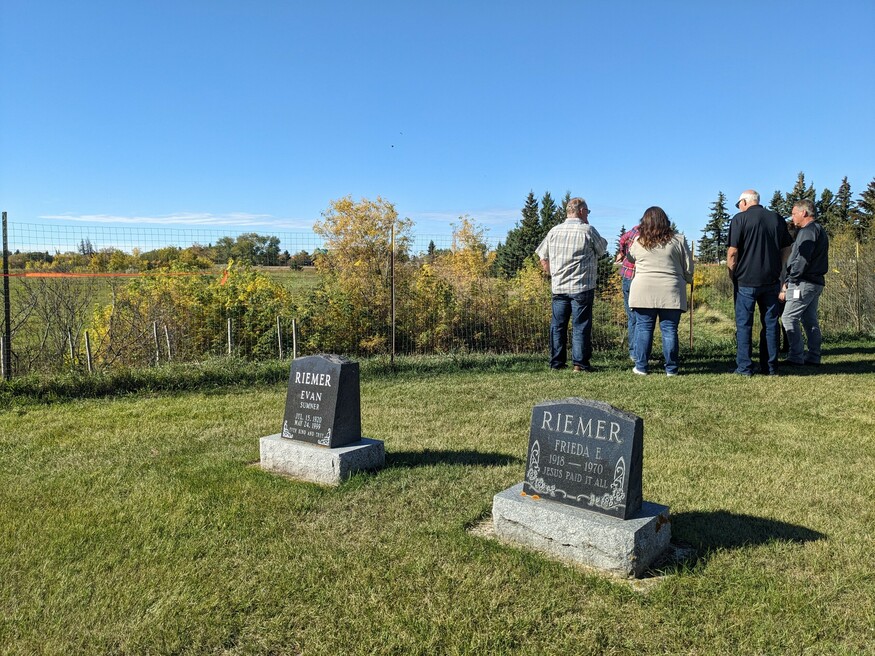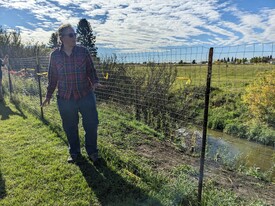
On Tuesday, September 24th, the town of Vegreville unveiled an innovative bank stabilization project at the Riverside Cemetery, along the banks of the Vermilion River. Like many other riverbanks adjacent to landscaped and disturbed areas (such as trails), the Riverside Cemetery began to experience significant bank erosion.
Brianne Giles had heard about projects which successfully stabilized and restored eroding areas with live plant material, called soil bioengineering. As Infrastructure Coordinator for the Town of Vegreville, Giles began to consider how this type of strategy could work at the Riverside Cemetery. With insights and expertise provided by Kristen Andersen of Associated Environmental, the Town began to investigate its options.
The solution was a lower-impact, cost-effective strategy to both improve the stability of the riverbank and contribute to the Vermilion River Watershed’s overall health and function. In 2022, the Town secured funding from the Government of Alberta's Watershed Resiliency and Restoration Program (WRRP), setting the project in motion.
Given her technical expertise and involvement in the project, Andersen presented at the unveiling event, explaining why soil bioengineering is an effective solution to bank erosion. She began by contrasting a more typical engineering solution with bioengineering and highlighting similar projects she and Associated Environmental have successfully constructed around Alberta.
Usually, significant bank erosion has been addressed through “armouring” riverbanks with hard engineering solutions such as concrete barriers. While traditional methods can provide immediate protection, they come at a cost. These hard-engineered structures require significant modifications, like decreasing the steepness of a slope to accommodate construction crews. Plus, the cost associated with hard-engineered interventions is high, given the specialized skills and materials needed for their design and construction.
Sites with armoured banks often have downstream impacts. Without natural bank features to slow the movement of runoff and stream flows, the force and quantity of water moving through the waterway increases and can cause downstream bank degradation.
In contrast, the approach taken by Vegreville focuses on enhancing the shoreline health to reduce erosion by establishing native riparian vegetation such as willow and poplar. These live stakes develop their own root systems rapidly. Within months, developing root systems work to both anchor the soil and absorb excess runoff.
Planting live stakes requires only hand tools and healthy cuttings that can be harvested from nearby riparian areas. On steeper riverbank sections, willow wattle fences run up the bank, acting similarly to small, tiered retaining walls. Once the planted riparian vegetation becomes established, the wattle fencing integrates and becomes a self-sustaining landscape feature with roots of its own.
Associated Environmental designed and led the installation of the live staking and wattle fencing at the Riverside Cemetery during the fall of 2023 and spring 2024. With the initial work of the project complete, maintenance is in the hands of the Town of Vegreville and some local volunteers.
In the four or five years after planting, weeding and watering is critical. For instance, allelopathic plants, such as Manitoba Maple and invasive Caragana, need to be removed regularly to stop them from suppressing and outcompeting the newly planted vegetation.
Another significant maintenance consideration is monitoring for and deterring beaver activity. Newly planted live stakes are very attractive to beavers, and with a lodge near the cemetery, the project site has already had to grapple with herbivory. Fencing has been installed around the project site to allow the live stakes to grow. While this type of site maintenance is needed in the early years, once the mature riparian vegetation at the project site develops, it will be able to withstand disturbances like herbivory and the fluctuating water levels common along the Vermilion River.
During Andersen’s presentation, she noted that if restoration projects like this become more common, it will go a long way to ensure overall watershed health.
Andersen explained that, beyond the immediate goal of stabilizing the riverbank, the Riverside Cemetery Bank Stabilization project can serve as a demonstration site for community members to learn more about nature-based solutions and get involved in maintaining and stewarding the project. The project site could inspire others experiencing similar erosion challenges as the Riverside Cemetery to learn about how to strengthen and restore the degraded riparian zones in their own backyards.The project site is publicly accessible and may be visited during the Cemetery’s standard operating hours. A short documentary profiling the project is in development and will be released by the Town of Vegreville in the coming months.

Kristen Andersen speaking at the project site during the Sept 24 educational presentation and site tour
See another Associated Environmental bank stabilization project in Devon, AB.